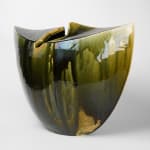KATO Yasukage XIV 十四代加藤康景
H37.8 x W49.6 x D25.2cm
Further images
-
(View a larger image of thumbnail 1
)

-
(View a larger image of thumbnail 2
)

-
(View a larger image of thumbnail 3
)

-
(View a larger image of thumbnail 4
)

-
(View a larger image of thumbnail 5
)

-
(View a larger image of thumbnail 6
)

-
(View a larger image of thumbnail 7
)

-
(View a larger image of thumbnail 8
)

-
(View a larger image of thumbnail 9
)

-
(View a larger image of thumbnail 10
)

-
(View a larger image of thumbnail 11
)

-
(View a larger image of thumbnail 12
)

-
(View a larger image of thumbnail 13
)

-
(View a larger image of thumbnail 14
)

The beautiful Oribe and Shino glazes of the ceramicist Kato Yasukage XIV 十四代 加藤康景 (1964- 2012) demonstrates his great talent. Born in Aichi to two professional potters, Kato began his studies as a young man under Bizen Living National Treasure Yamamoto Toshu 山本陶秀 (1906- 1994), with whom he developed his own mentori (faceted) formal style. Together, his family's history and his apprenticeship provided a solid foundation on which he built a strong artistic practice, in one sense quite literally: Kato often used clay that had been prepared by his ancestors. This was special clay passed down for generations in his family, a tradition that Kato embraced by preparing clay for his own descendants.
Kato works in an iron-rich mountain clay that reacts to the heat of the kiln to produce luscious green colors in his Oribe glazes, and firey red in his red Shino glazes. The artist prefers a wood kiln, which is very difficult to control but produces beautiful results. Although Kato's life was tragically cut short by a car accident in 2012, his Oribe & Shino works continue to delight and inspire.
This Oribe vase is an excellent, large piece made in his later years. It does not come with a box as it is too large. However, it is signed at the base.
Famous for its patches of copper green, its variety of colorful gradations that the glaze type permits and playful decorations, Oribe ware is an indispensable part of any Japanese Modern art collection. In its inception, Oribe ware was known for its daring departure from monochrome conventions in pottery during the Keichō and Genna eras (1596–1624). This ahead-of-its-time experimental spirit lives on in modern ceramics in the work of our Autumn selection of artists and potters who are at the forefront of carrying the tradition and spirit of Oribe into the future. The spirit of Oribe is, ultimately, daring.













